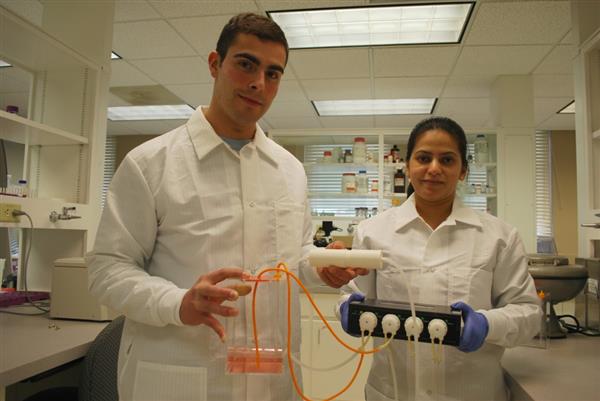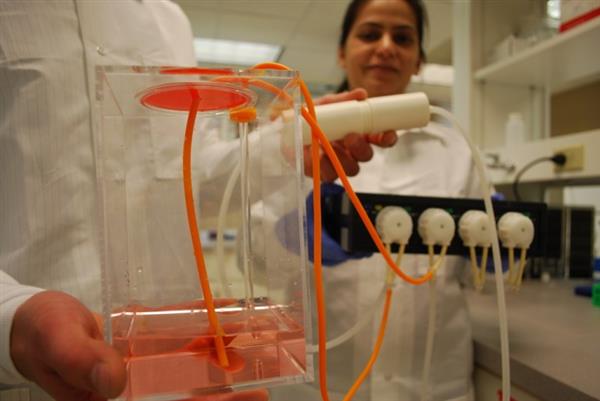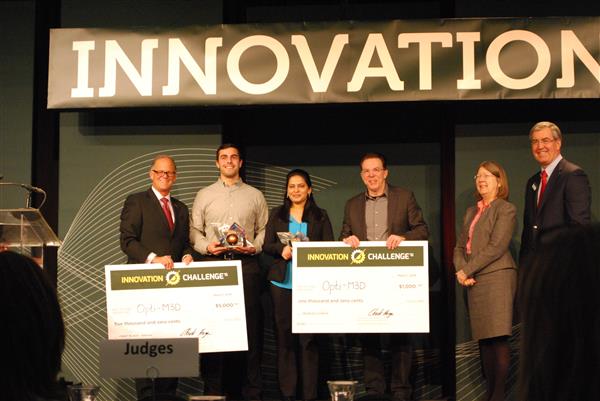
Graduate students Prajakta Kulkarni and Matthew Confeld began the Opti-M3D project last summer with the goal of overturning the ineffective cancer treatment methods in practice today. Currently, once a patient is diagnosed, they are prescribed a drug regiment based off of clinical trials of patients with a similar cancer. However, since cancer cells vary greatly from one person to the next, there’s no telling whether those clinical trials have any relevance to the patient in question.
«To say a treatment is effective is to say it works 50% of the time in patients," explained Confeld. «And that’s high for most drugs.»
Another issue with the current method is that, even if the anti-cancer drug doesn’t prove to be effective, it can still cause a range of distressing side-effects, including hair loss, nausea, vomiting, problems with red and white blood cells, etc. «The less you can give the patient, the better for them," said Confeld.
Kulkarni and Confeld’s proposed solution is to clone three-dimensional tumors from the patients’ own cancer cells in order to test a multitude of anti-cancer drugs. Because multiple drugs can be tested at once, the process saves the patient precious time, money, and physical distress. «Instead of a patient undergoing a treatment, and trial and error over that treatment, we can treat all the replicas of those tumors in a complex environment outside of the body," explained Kulkarni.»

The Opti-M3D is centered on a biodegradable 3D printed capsule, which hosts the tumor as it grows. Cancer cells are placed inside the 3D printed capsule, which is then connected to tanks containing ‘cell culture media’-i.e., the conditions within the body that allow cells to survive and grow. The cell culture media is pumped throughout the capsule, simulating the blood flow of an actual human body, and encouraging the cells to grow into a 3D tumor.
The process sounds simple enough, yet it did require some resourcefulness: the students didn’t have access to their own 3D printer, but were able to use UPS 3D printing services to manufacture their cell-hosting capsule. The pump used to connect the capsule to the cell culture tank was originally designed for a fish aquarium, and the cancer cells they used to test the device? Those were purchased online (from a dedicated research cell provider, of course).

Not only were the students able to successfully clone the cancer cells, but they also discovered they could create up to four tumors at a time. That could means four times less ‘trial and error’ for patients to physically undergo, and a much speedier route to finding the most effective cancer treatment.
Using this process, Kilkarni and Confeld believe testing would take around 15–20 days depending on the cancer. They could also use the cloned cancer tumors to conduct ongoing tests and track if the cancer develops a resistance to certain drugs.
«We can do a follow-up and continue to grow those tumors and treat them," explained Confeld. «If resistance does develop, we can alart the physician and say there is resistance developing, you might want to alert the patient and see if it’s happening in them too.»
Finally, a major advantage of testing anti-cancer drugs on cloned tumors is the cost savings. Many drugs can cost between $10,000 to $20,000 or more a month, yet by singling out the tumor rather than administering them to the patient’s entire body, doctors could use much smaller amounts of the drug, and potentially save patients thousands of dollars.
Kulkarni and Confeld submitted the Opti-M3D to the NDSU’s Innovation Challenge under the Service Track. Their 3D printed invention earned them the First Place Prize as well as People’s Choice Award, valued at $5,000 and $1,000 respectively-which will probably go towards buying them their own 3D printer (sorry, UPS).

Though they are currently taking a break to finish their current studies (Kulkarni is writing her thesis, also about cancer treatment, while Confeld is finishing his studies in pharmacy and preparing to begin his PhD), they will move forward with developing the Opti-M3D in the near future.
Project advisor and PhD professor of pharmacy Sanku Mallik is assisting them in securing a patent through the NDSU’s Tech Transfer office, and Kulkarni is pursuing funds from the North Dakota Department of Commerce. Eventually, the Opti-M3D tumor-cloning apparatus could be offered as a service for hospitals and cancer research centers.
«It’s going to have tremendous impact," Mallik said. «It’s going to touch the lives of many cancer patients.
Last month, researchers in Australia also revealed that they are developing a patient-specific 3D printed cancer treatment that targets the tumor rather than the whole body.
While most doctors (and patients) want to eliminate tumors forever, that may not be possible anytime in the near future. However, going the opposite route and cloning them could actually be the key to treating them more effectively and improving cancer patients' lives.
Source:
http://www.3ders.org/articles/20160425-3d-printed-tumor-cloning-device-could-lead-to-more-effective-...






